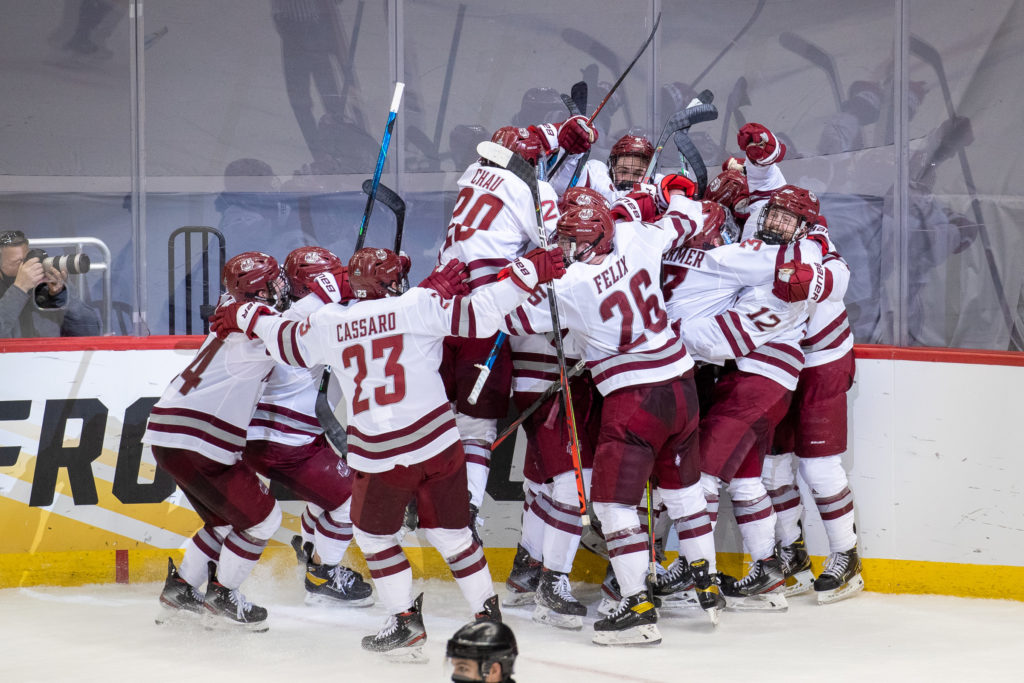
It’s finally that time of year where everyone is wondering what teams will make the NCAA men’s Division I ice hockey tournament and, more so, where their favorite teams will likely be playing.
Thus, we’ll dust off the old column called Bracketology. Each week until selection Sunday, Jayson Moy and I try to give you some perspective on what the NCAA field will look like based on the current PairWise Rankings.
(Note: today’s column is written on Tuesday, February 22, before certain games were played. Thus, those results aren’t factored into the PairWise we are using for this column).
Let’s begin with the basics: the 16 teams that would qualify for the tournament if the season ended today. Five of the six conferences are represented in the current PairWise, the one exception being Atlantic Hockey. Thus, we will include their top team, American international, as the number 16 team.
Here is the current NCAA field:
1. Michigan
2. Minnesota State
3. Denver
4. Western Michigan
5. Minnesota
6. North Dakota
7. Quinnipiac
8. Minnesota Duluth
9. Massachusetts
10. St. Cloud State
11. Notre Dame
12. Michigan Tech
13. Ohio State
14. Boston University
15. Connecticut
16. AIC
With these 16 teams established, we’ll try to keep in mind a number of things when seeding each region.
• In an ideal world, the NCAA would like the number one seeds to play as close to home as possible. Right now, all four number one seeds are western teams and two regions (some could argue three when you consider the location of Allentown, Pa.) are located in the east. Thus, where each of the four number one seeds head is somewhat irrelevant.
• If there is a host team participating, they must be placed in their home region. Denver, hosting in Loveland, Colo., is the only host team right now. Thus Denver will play in Loveland.
• When possible, you should maintain bracket integrity (1 vs. 16, 2 vs. 15, etc.) as much as possible.
• Lastly, and most importantly, when possible you must avoid two teams from the same conference playing one another in the first round.
We have often discussed attendance concerns for the regionals and while we believe that is always on the minds of the NCAA, we’ve seen in recent years that maintaining bracket integrity is often just as, if not more, important.
With all of that in mind, Jayson and I have each created our own brackets, with our rationale on how we each get to the end point included.
Jayson’s Bracket
Let me start out by putting everyone into bracket integrity. That means:
1 Michigan
8 Minnesota-Duluth
9 Massachusetts
16 AIC
2 Minnesota State
7 Quinnipiac
10 St. Cloud State
15 Connecticut
3 Denver
6 North Dakota
11 Notre Dame
14 Boston University
4 Western Michigan
5 Minnesota
12 Michigan Tech
13 Ohio State
Looking at the brackets, there is no intra-conference matchups in the first round. So I am good.
Now, I am going to place the brackets in the Regionals – as is.
Denver has to go to Loveland. Plain and simple.
Now we are left with Allentown, Worcester and Albany.
Maximizing attendance, I will go for:
Worcester: Michigan bracket
Albany: Minnesota State bracket
Allentown: Western Michigan bracket
The only suspect bracket here becomes the Allentown bracket, as the attendance could be iffy. Would moving Michigan to Allentown help there? Not without sacrificing Worcester. Either way, one regional will get thrown to the wolves because of attendance.
But, that is what I will stick with following the two simple rules of Bracket Integrity and Attendance.
And for one more reason – host schools/conferences. Denver we know about. The ECAC is hosting in Albany, it gets Quinnipiac. Holy Cross is hosting in Worcester, it gets AIC. And Penn State is hosting in Allentown, it gets Minnesota and Ohio State.
It works out for me.
Jim’s Bracket
Basically, I seeded the tournament 1-16 in order sending the number one seeds as follows:
1. Michigan (Allentown)
2. Minnesota State (Albany)
3. Denver (Loveland – host)
4. Western Michigan (Worcester)
That yielded:
Allentown
1. Michigan
2. Minnesota Duluth
3. UMass
4. AIC
Albany
1. Minnesota State
2. Quinnipiac
3. St. Cloud State
4. UConn
Loveland
1. Denver
2. North Dakota
3. Notre Dame
4. Boston Univ.
Worcester
1. Western Michigan
2. Minnesota
3. Michigan Tech
4. Ohio State
And here are the edits I made and the reasoning:
First off, let’s switch two matchups wholesale – take the Minnesota-Michigan Tech matchup and move it from Worcester to Allentown, swapping it for Minnesota Duluth and UMass. That gets UMass a lot closer to home to help with attendance in Worcester. Let’s also switch Ohio State and Boston University, moving OSU to what likely becomes a default “all-west” regional in Loveland and brings Boston University back to Worcester.
That leaves us with:
Allentown
1. Michigan
2. Minnesota
3. Michigan Tech
4. AIC
Albany
1. Minnesota State
2. Quinnipiac
3. St. Cloud State
4. UConn
Loveland
1. Denver
2. North Dakota
3. Notre Dame
4. Ohio State
Worcester
1. Western Michigan
2. Minnesota Duluth
3. UMass
4. Boston University
Sure, Allentown still has a major attendance concern but that will happen regardless given its location. What team in the field will help that region? I’m not sure there is one.
Now that the dust clears, here are the final brackets for each:
Jayson’s Bracket
Worcester
1. Michigan
2. Minnesota-Duluth
3. Massachusetts
4. AIC
Albany
1. Minnesota State
2. Quinnipiac
3. St. Cloud State
4. Connecticut
Loveland
1. Denver
2. North Dakota
3. Notre Dame
4. Boston University
Allentown
1. Western Michigan
2. Minnesota
3. Michigan Tech
4. Ohio State
Jim’s Bracket
Allentown
1. Michigan
2. Minnesota
3. Michigan Tech
4. AIC
Albany
1. Minnesota State
2. Quinnipiac
3. St. Cloud State
4. UConn
Loveland
1. Denver
2. North Dakota
3. Notre Dame
4. Ohio State
Worcester
1. Western Michigan
2. Minnesota Duluth
3. UMass
4. Boston University


